The MSI MEG Z690 Unify (DDR5) Motherboard Review: The All-Black Option
by Gavin Bonshor on January 18, 2022 10:00 AM ESTCPU Performance, Short Form
For our motherboard reviews, we use our short form testing method. These tests usually focus on if a motherboard is using MultiCore Turbo (the feature used to have maximum turbo on at all times, giving a frequency advantage), or if there are slight gains to be had from tweaking the firmware. We put the memory settings at the CPU manufacturers suggested frequency, making it very easy to see which motherboards have MCT enabled by default.
For Z690 we are running using Windows 10 64-bit with the 20H2 update.
Rendering - Blender 2.79b: 3D Creation Suite
A high profile rendering tool, Blender is open-source allowing for massive amounts of configurability, and is used by a number of high-profile animation studios worldwide. The organization recently released a Blender benchmark package, a couple of weeks after we had narrowed our Blender test for our new suite, however their test can take over an hour. For our results, we run one of the sub-tests in that suite through the command line - a standard ‘bmw27’ scene in CPU only mode, and measure the time to complete the render.
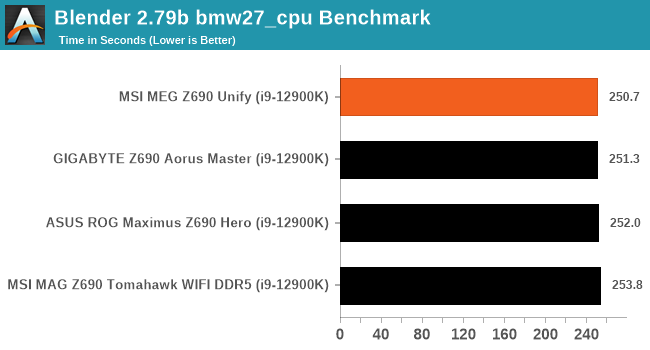
Rendering - Crysis CPU Render
One of the most oft used memes in computer gaming is ‘Can It Run Crysis?’. The original 2007 game, built in the Crytek engine by Crytek, was heralded as a computationally complex title for the hardware at the time and several years after, suggesting that a user needed graphics hardware from the future in order to run it. Fast forward over a decade, and the game runs fairly easily on modern GPUs, but we can also apply the same concept to pure CPU rendering – can the CPU render Crysis? Since 64 core processors entered the market, one can dream. We built a benchmark to see whether the hardware can.
For this test, we’re running Crysis’ own GPU benchmark, but in CPU render mode. This is a 2000 frame test, which we run over a series of resolutions from 800x600 up to 1920x1080. For simplicity, we provide the 1080p test here.
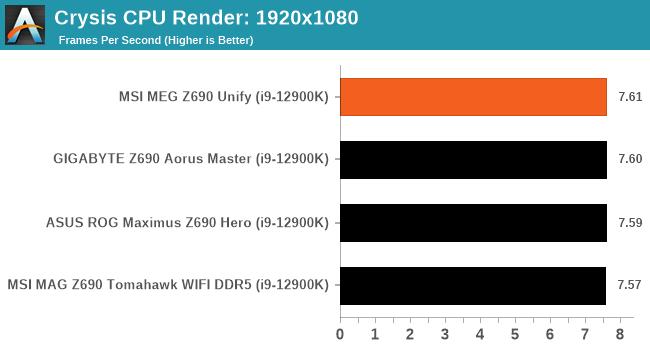
Rendering - Cinebench R23: link
Maxon's real-world and cross-platform Cinebench test suite has been a staple in benchmarking and rendering performance for many years. Its latest installment is the R23 version, which is based on its latest 23 code which uses updated compilers. It acts as a real-world system benchmark that incorporates common tasks and rendering workloads as opposed to less diverse benchmarks which only take measurements based on certain CPU functions. Cinebench R23 can also measure both single-threaded and multi-threaded performance.


Synthetic - GeekBench 5: Link
As a common tool for cross-platform testing between mobile, PC, and Mac, GeekBench is an ultimate exercise in synthetic testing across a range of algorithms looking for peak throughput. Tests include encryption, compression, fast Fourier transform, memory operations, n-body physics, matrix operations, histogram manipulation, and HTML parsing.
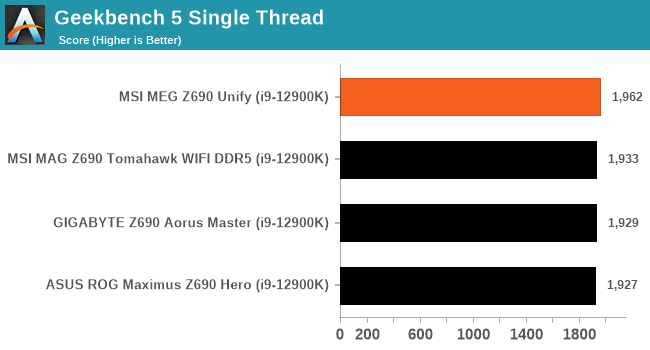
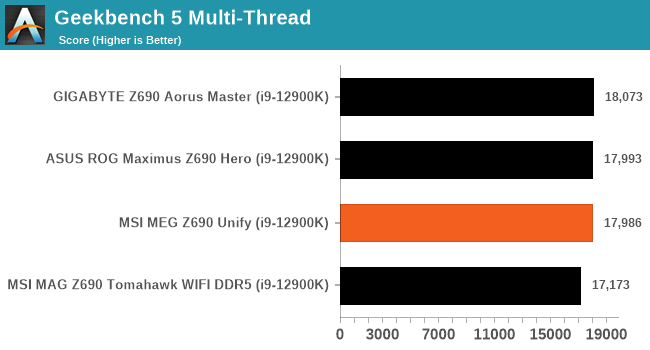
Compression – WinRAR 5.90: link
Our WinRAR test from 2013 is updated to the latest version of WinRAR at the start of 2014. We compress a set of 2867 files across 320 folders totaling 1.52 GB in size – 95% of these files are small typical website files, and the rest (90% of the size) are small 30-second 720p videos.
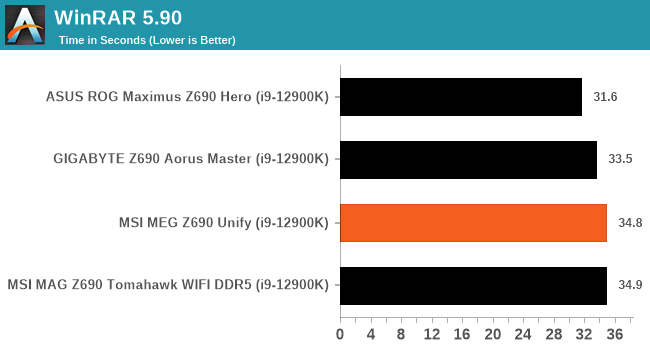
3DPMv2.1 – 3D Movement Algorithm Test: link
3DPM is a self-penned benchmark, taking basic 3D movement algorithms used in Brownian Motion simulations and testing them for speed. High floating point performance, MHz, and IPC win in the single thread version, whereas the multithread version has to handle the threads and loves more cores. For a brief explanation of the platform agnostic coding behind this benchmark, see my forum post here.
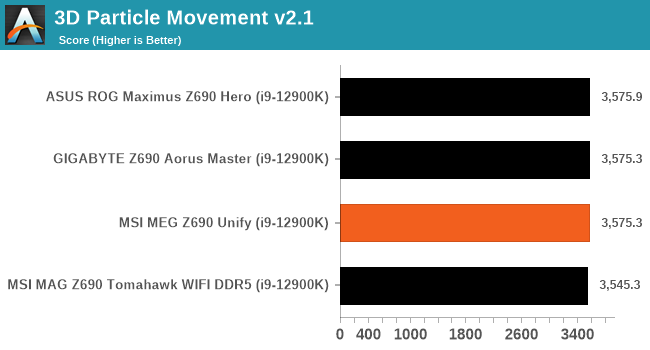
NAMD 2.13 (ApoA1): Molecular Dynamics
One frequent request over the years has been for some form of molecular dynamics simulation. Molecular dynamics forms the basis of a lot of computational biology and chemistry when modeling specific molecules, enabling researchers to find low energy configurations or potential active binding sites, especially when looking at larger proteins. We’re using the NAMD software here, or Nanoscale Molecular Dynamics, often cited for its parallel efficiency. Unfortunately the version we’re using is limited to 64 threads on Windows, but we can still use it to analyze our processors. We’re simulating the ApoA1 protein for 10 minutes, and reporting back the ‘nanoseconds per day’ that our processor can simulate. Molecular dynamics is so complex that yes, you can spend a day simply calculating a nanosecond of molecular movement.
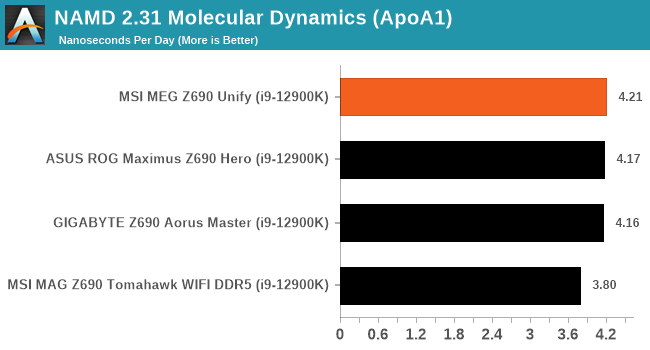


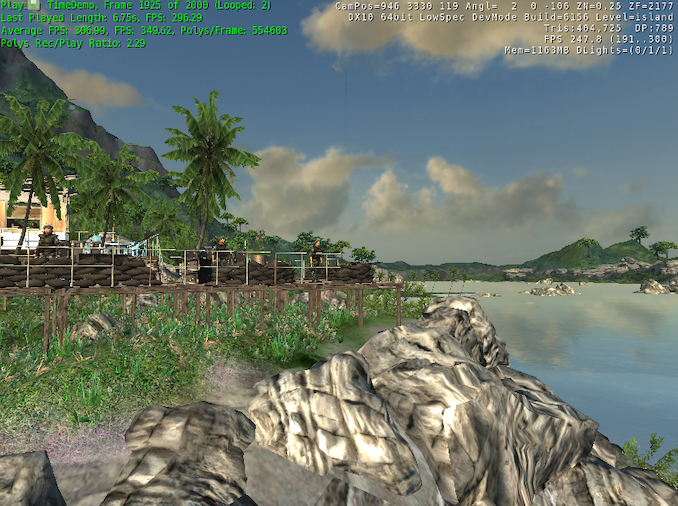








20 Comments
View All Comments
mrvco - Tuesday, January 18, 2022 - link
I embrace our post Peak RGB world.meacupla - Tuesday, January 18, 2022 - link
MSI VRMs running a bit warmer than the competition seems to be pretty normal.I just wish they would use heatsinks with more surface area.
erinadreno - Wednesday, January 19, 2022 - link
agree. People have figured out they should use finned aluminum/copper as heatsinks on CPU. Why couldn't they apply this knowledge on to the VRMolde94 - Wednesday, January 19, 2022 - link
yeah it's almost as if larger surface area helps!Oxford Guy - Friday, January 21, 2022 - link
Tons of boards in the past had VRM sinks with lots of pure metal fins. Some even had copper heatpipes to connect to multiple heavy-duty highly-finned sinks.HollyDOL - Wednesday, January 19, 2022 - link
no RGB? Sold!JamesWoods - Monday, January 24, 2022 - link
You know you can just turn most RGBs off...right?Mikehawkest - Sunday, March 27, 2022 - link
Stfu and go watch Barney.PeachNCream - Friday, January 21, 2022 - link
No RGB is good, but its still far more sensible to buy a budget computing equipment which is already RGB-free and use modest hardware for much lower cost and then you can squirrel away the difference in cost to upgrade more frequently and leap ahead in performance without bothering with overclocking, high wattage PSUs, or loads of waste heat. Or just set your expectations a bit lower and find a way to kill time on lesser, more efficient hardware. For instance, I still do most of my gaming on a Celeron n3060 in a purple HP Stream 11 running Linux and kill off just as many hours being just as amused as someone that spent vastly more money and feeds orders of magnitude more power to their PC. - And I don't have RGB lighting AND I can easily take my computer somewhere else with me rather than being stuck in a fixed location with a stationary, wired-to-the-wall desktop.Badelhas - Saturday, January 22, 2022 - link
What kind of games do you play?